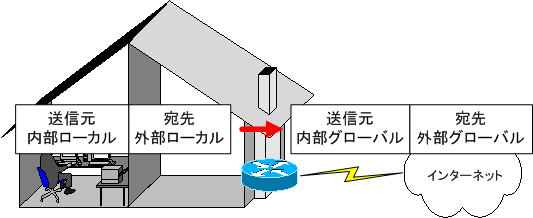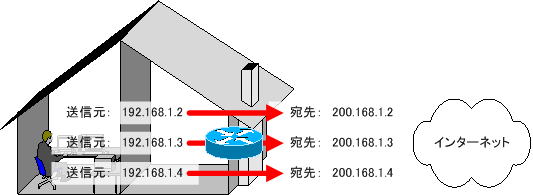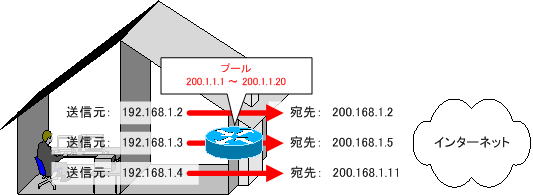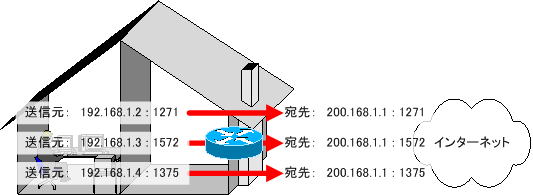NATとは
インターネットが急成長してくると、IPアドレス枯渇の問題が浮かび上がり、これに対処するためにいくつかの解決策が開発されました。その1つの解決策が、NAT(Network Address Translation)です。
NATを使用すると構内でのみ使用できるプライベートIPアドレスを、インターネットで使用できるグローバルIPアドレスに変換できます。そうすることによって、プライベートIPアドレスが割り当てられた端末が、透過的にインターネットにアクセスできるようになります。
NATがなければ、プライベートIPアドレスが割り当てられた端末は、インターネットにアクセスすることはできません。
グローバルIPアドレスを端末の台数だけ取得するのは、もはや困難です。NATを使うことにより、個々の企業、自宅において、プライベートIPアドレスを端末に割り当て、取得したグローバルIPアドレスに変換することで、インターネットへ接続を提供することができます。
NATの種類
NATには、次の3つの方式があります。
- スタティックNAT
- ダイナミックNAT
- IPマスカレード(NAPT)
プライベートIPアドレスとグローバルIPアドレスの対応が常に1対1になる「スタティックNAT」、用意したグローバルIPアドレスのプールのなかで、プライベートIPアドレスとグローバルIPアドレスと1対1に対応させる「ダイナミックNAT」、TCP/UDPのポートを管理することで1つのグローバルIPアドレスでローカルIPアドレスが設定された複数の端末を同時に通信できるようにする「IPマスカレード」があります。
このNAT機能は、安価なブロードバンドルータでもサポートしています。
NATの設定を行う前に、下の表のNATの用語を知っておく必要があります。紛らわしくて覚えにくいと思いますが、この呼び方と違いについて理解しておきましょう!
| 種類 | 意味 |
| 内部ローカルアドレス | LAN内で使用しているプライベートIPアドレス |
| 内部グローバルアドレス | アウトサイドで使用するIPアドレス。通常は、ISPから取得したグローバルIPアドレス。 |
| 外部ローカルアドレス | LAN内で宛先としている外部へのIPアドレス |
| 外部グローバルアドレス | 通信相手が取得しているグローバルIPアドレス。通常は、外部グローバルアドレスと外部ローカルアドレスは、同じ。 |
NAT変換は、内部ローカルアドレスと外部ローカルアドレスの変換が、基本になります。

ローカル ・・・ LAN
グローバル ・・・ インターネット
内部 ・・・ 送信元
外部 ・・・ 宛先
と当てはめて、考えると理解しやすいかもしれません。
スタティックNAT
「スタティックNAT」は、プライベートIPアドレスとグローバルIPアドレスの対応が常に1対1にマッピングされる方法です。IPアドレスとグローバルIPアドレスの対応が常に固定したい場合に使用します。
スタティックNATでは、用意しているグローバルIPの数しか、ローカル端末は、外部(インターネット)へ接続ができません。

ダイナミックNAT
プライベートIPアドレスと用意したグローバルIPアドレスのプールの中から1つのグローバルIPアドレスとを1対1に対応させるのが「ダイナミックNAT」です。

上の図の例では、プールの200.1.1.1~200.1.1.20の範囲内で、内部グローバルアドレスに変換されます。
IPマスカレード(NAPT)
「IPマスカレード(NAPT)」は、TCP/UDPのポートを管理することで1つのグローバルIPアドレスでローカルIPアドレスが設定された複数の端末を同時に通信できるようにします。
「IPマスカレード(NAPT)」は、Ciscoでは、「PAT(オーバーローディング)」と呼んでいます。

※ここでは、理解しやすいように送信元のポート番号と変換されるポート番号を同じにしていますが、実際には、異なる場合があります。
